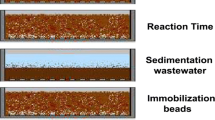Abstract
Monoethylene glycol (MEG) is used in the oil and gas industry to prevent freezing along well-to-refinery natural-gas transmission lines. Once the gas reaches the refinery, the MEG is then separated from the gas. In this process MEG is introduced to the refinery wastewater, making it extremely polluted and hazardous to the aquatic environment. Therefore, it is important to remove this substance from refinery wastewaters. This study examined the use of a microorganism in a glass reactor to remove MEG from wastewater generated at South Pars Gas Field Phase 4, Bushehr, Iran. A novel reactor satisfying the experimental conditions was built. The microorganism Aspergillus tubingensis was isolated from wastewater containing MEG and identified using a polymerized chain reaction buffer. The microorganism was fixed on a packed bed and transported to the glass reactor. Sampling and measurements of chemical oxygen demand (COD), pH values, and MEG concentration were performed at different periods. After 240 h, a 65 % decrease in COD was achieved and MEG concentration was reduced by more than 40 %.







Similar content being viewed by others
References
Esmaeili, A., Sadeghi, E.: The efficiency of Penicillium commune for bioremoval of industrial oil. Int. J. Environ. Sci. Technol. 11, 1271–1276 (2014)
Aguilar-Arteaga, K., Rodriguez, J., Barrado, E.: Magnetic solids in analytical chemistry: a review. Anal. Chim. Acta 674(2), 157–165 (2010)
Ghogare, P., Gupta, S.: Degradation of mono ethylene glycol by few selected microorganisms and developed microbial consortium. Int. J. Microbiol. Res 3(2), 93–98 (2012)
Akar, S.T., Akar, T., Çabuk, A.: Decolorization of a textile dye, Reactive Red 198 (RR198), by Aspergillus parasiticus fungal biosorbent. Braz. J. Chem. Eng. 26(2), 399–405 (2009)
Esmaeili, A., Fazeli, S.: Investigation of biodegradation of an aromatic compound in industrial waste water. Rom. J. Biochem. 49(2), 153–161 (2012)
Esmaeili, A., Kalantari, M.: Bioremoval of an azo textile dye, Reactive Red 198, by Aspergillus flavus. World J. Microbiol. Biotechnol. 28(3), 1125–1131 (2012)
Lanouette, K.: Treatment of phenolic wastes. Chem. Eng. 84(22), 99–106 (1977)
Chehregani, A., Malayeri, B.E.: Removal of heavy metals by native accumulator plants. Int. J. Agric. Biol. 9(3), 462–465 (2007)
Fusey, P., Oudot, J.: Relative influence of physical removal and biodegradation in the depuration of petroleum-contaminated seashore sediments. Mar. Pollut. Bull. 15(4), 136–141 (1984)
Wood, J.: Microbial fermentation of lower terpenoids. Process Biochem. 2, 50–52 (1969)
Cuny, P., Faucet, J., Acquaviva, M., Bertrand, J.C., Gilewicz, M.: Enhanced biodegradation of phenanthrene by a marine bacterium in presence of a synthetic surfactant. Lett. Appl. Microbiol. 29(4), 242–245 (1999)
Kachuei, R., Yadeghari, M.H., Rezaie, S., Allameh, A., Naser, S., Farideh, Z., Fatemeh, K.Y.: Investigation of stored wheat mycoflora, reporting the Fusarium cf. langesethiae in three provinces of Iran during 2007. Ann. Microbiol. 59(2), 383–390 (2009)
Zope, V., Kulkarni, M., Chavan, M.: Biodegradation of synthetic textile dyes reactive red 195 and reactive green 11 by Aspergillus niger grp: an alternative approach. J. Sci. Ind. Res. 66(5), 411–414 (2007)
Adams, R.P.: Identification of essential oils by ion trap mass spectroscopy. Academic Press, Waltham (2012)
Dadpour, B., Shafahi, A., Monzavi, S.M., Zavar, A., Afshari, R., Khoshdel, A.R.: Snakebite prognostic factors: leading factors of weak therapeutic response following snakebite envenomation. Asia Pac. J. Med. Toxicol. 1(1), 27–33 (2012)
Bossert, I., Bartha, R.: The fate of petroleum in soil ecosystems. In: Atlas, R.M. (ed.) Petroleum microbiology, pp. 435–473. MacMillan, New York (1984)
Leahy, J.G., Colwell, R.R.: Microbial degradation of hydrocarbons in the environment. Microbiol. Rev. 54(3), 305–315 (1990)
Atlas, R.M., Bartha, R.: Microbial ecology: fundamentals and applications. Addison-Wesley Publishing Company, Reading (1981)
Walker, J., Colwell, R.R.: Microbial degradation of model petroleum at low temperatures. Microb. Ecol. 1(1), 63–95 (1974)
Verstraete, W., Vanloocke, R., DeBorger, R., ve Verlinde, A.: Modelling of the breakdown and the mobilization of hydrocarbons in unsaturated soil layers. In: Sharpley, J.M. and Kaplan, A.M. (eds.) Proceeding of the 3rd International Biodegradation Symposium, pp. 99–112. Applied Science Publishers, London (1976)
Spain, J.C., Pritchard, P., Bourquin, A.: Effects of adaptation on biodegradation rates in sediment/water cores from estuarine and freshwater environments. Appl. Environ. Microbiol. 40(4), 726–734 (1980)
Esmaeili, A., Fazeli, S., Moazami, N.: Microbial transformation of α-naphthol by Aspergillus niger–PTCC 5011. Herba Polon. 58(2), 38 (2012)
Verma, P., Madamwar, D.: Comparative study on transformation of azo dyes by different white rot fungi. Indian J. Biotechnol. 1, 393–396 (2002)
Author information
Authors and Affiliations
Corresponding author
Rights and permissions
About this article
Cite this article
Esmaeili, A., Loghmani, K. Removal of Monoethylene Glycol from Gas Field Wastewater Using Aspergillus tubingensis and a New Bioreactor. Waste Biomass Valor 7, 151–156 (2016). https://doi.org/10.1007/s12649-015-9430-z
Received:
Accepted:
Published:
Issue Date:
DOI: https://doi.org/10.1007/s12649-015-9430-z




